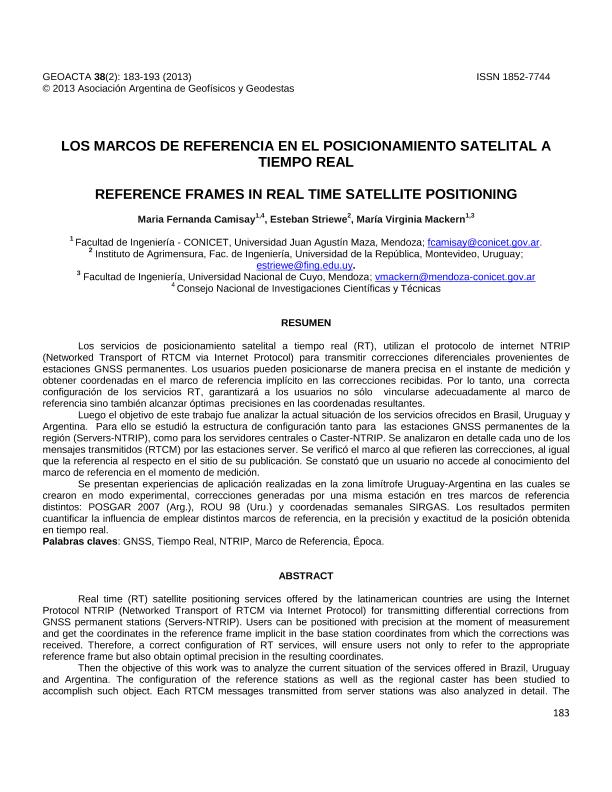Artículo
Los servicios de posicionamiento satelital a tiempo real (RT), utilizan el protocolo de internet NTRIP (Networked Transport of RTCM via Internet Protocol) para transmitir correcciones diferenciales provenientes de estaciones GNSS permanentes. Los usuarios pueden posicionarse de manera precisa en el instante de medición y obtener coordenadas en el marco de referencia implícito en las correcciones recibidas. Por lo tanto, una correcta configuración de los servicios RT, garantizará a los usuarios no sólo vincularse adecuadamente al marco de referencia sino también alcanzar óptimas precisiones en las coordenadas resultantes. Luego el objetivo de este trabajo fue analizar la actual situación de los servicios ofrecidos en Brasil, Uruguay y Argentina. Para ello se estudió la estructura de configuración tanto para las estaciones GNSS permanentes de la región (Servers-NTRIP), como para los servidores centrales o Caster-NTRIP. Se analizaron en detalle cada uno de los mensajes transmitidos (RTCM) por las estaciones server. Se verificó el marco al que refieren las correcciones, al igual que la referencia al respecto en el sitio de su publicación. Se constató que un usuario no accede al conocimiento del marco de referencia en el momento de medición. Se presentan experiencias de aplicación realizadas en la zona limítrofe Uruguay-Argentina en las cuales se crearon en modo experimental, correcciones generadas por una misma estación en tres marcos de referencia distintos: PORGAR 2007 (Arg.), ROU 98 (Uru.) y coordenadas semanales SIRGAS. Los resultados permiten cuantificar la influencia de emplear distintos marcos de referencia, en la precisión y exactitud de la posición obtenida en tiempo real. Real time (RT) satellite positioning services offered by the latinamerican countries are using the Internet Protocol NTRIP (Networked Transport of RTCM via Internet Protocol) for transmitting differential corrections from GNSS permanent stations (Servers-NTRIP). Users can be positioned with precision at the moment of measurement and get the coordinates in the reference frame implicit in the base station coordinates from which the corrections was received. Therefore, a correct configuration of RT services, will ensure users not only to refer to the appropriate reference frame but also obtain optimal precision in the resulting coordinates.
Then the objective of this work was to analyze the current situation of the services offered in Brazil, Uruguay and Argentina. The configuration of the reference stations as well as the regional caster has been studied to accomplish such object. Each RTCM messages transmitted from server stations was also analyzed in detail. The reference frames of the coordinates were verified, as well as the reference to it in the publishing site. It was found that a user does not have information of the framework at the time of measurement.
Results of experiences performed in the Uruguay - Argentina border zone were presented. Experimental streams was created from the same station on three different reference frames: POSGAR 2007 (Arg) , ROU 98 (Uru.) and weekly SIRGAS coordinates. These results quantify the influence of using different reference frames in the accuracy of the real time positioning.
Los marcos de referencia en el posicionamiento satelital a tiempo real
Título:
Reference frames in real time satellite positioning
Fecha de publicación:
12/2013
Editorial:
Asociación Argentina de Geofísicos y Geodestas
Revista:
GEOACTA
ISSN:
1852-7744
Idioma:
Español
Tipo de recurso:
Artículo publicado
Clasificación temática:
Resumen
Archivos asociados
Licencia
Identificadores
Colecciones
Articulos(CCT - MENDOZA)
Articulos de CTRO.CIENTIFICO TECNOL.CONICET - MENDOZA
Articulos de CTRO.CIENTIFICO TECNOL.CONICET - MENDOZA
Citación
Camisay, Maria Fernanda; Striewe Dieste, Esteban; Mackern Oberti, María Virginia; Los marcos de referencia en el posicionamiento satelital a tiempo real; Asociación Argentina de Geofísicos y Geodestas; GEOACTA; 38; 2; 12-2013; 183-193
Compartir




